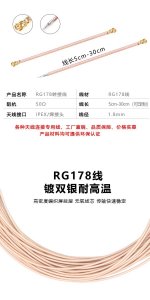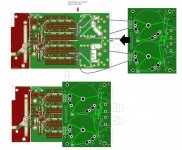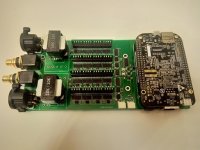Sure, I have guys who tried and preffered DM38PRO over SE38PRO.Would a dual-mono approach work with the transformers?
Question is why and what for the two versions are existing for Buffalo III for Dual Mono configuration...
I just trying to understand is the version of two Mercury boards is really used by someone at all, and what are the benefits over the single Mercury? Single Mercury board sounds worse when loaded on full 8 channels or what? Or is it just a willing to fully separate PSU's for Left and Right channels by using two Mercury boards? But in this case it looks like in case of two Mercury boards usage, the half of 38PRO chip channels on each Buffalo board are just not used, isn't it?
Thank you for the offer yunyun. I will think about it. The stock might be too high given the case I have planned but will see.
Also, where did you order the thick u.fl cables you are using?
Yes, the u.fl cables I used are really thick, with a wire diameter of 1.8mm, double silver-plated, and the price is very low, each one is 0.2 US dollars. I have a lot of them, so it’s not a problem to give you a few for free.

Last edited:
You can already ready power the Mercury separately so the advantage isn't further separation at the i/v stage but with using two DACs (one for L and one for R). Older implementations of a dual mono buffalo DAC have used one I/V stage but dual DACs.
(Twisted Pear Audio Support
sts/t3570-Dual-Mono-Buffalo--Problem-with-summing-odd-and-even-DACS)
(Twisted Pear Audio Support
sts/t3570-Dual-Mono-Buffalo--Problem-with-summing-odd-and-even-DACS)
Sure, I have guys who tried and preffered DM38PRO over SE38PRO.
Question is why and what for the two versions are existing for Buffalo III for Dual Mono configuration...
I just trying to understand is the version of two Mercury boards is really used by someone at all, and what are the benefits over the single Mercury? Single Mercury board sounds worse when loaded on full 8 channels or what? Or is it just a willing to fully separate PSU's for Left and Right channels by using two Mercury boards? But in this case it looks like in case of two Mercury boards usage, the half of 38PRO chip channels on each Buffalo board are just not used, isn't it?
Thanks.
In this case I recommend you to increase both the loading resistor to 2k and the input sensitivity of your AHB2 to Mid-Gain. Should sounds betterTry please...
I just swapped the 1k resistors for 2k. I am going to let it play for a bit but it sounds a bit more thin. Might need break in time and it might also be due to using the DAC and PC volume control at a lower volume.
What does 2k do for the sound vs. 1k other than gain?
You can already ready power the Mercury separately so the advantage isn't further separation at the i/v stage but with using two DACs (one for L and one for R). Older implementations of a dual mono buffalo DAC have used one I/V stage but dual DACs.
()
Thus it looks like there was a problem with simultaneous working of all 8 DACs in phase while using both I2S and SPDIF inputs. Looks like a bug inside the 38PRO chip, but I just reffering to this guide: [url]http://www.twistedpearaudio.com/docs/community_docs/leonvb-Buffalo_III_DAC_Integration_Guide_V2.1.3.pdf
where the single I/V for two Buffalo boards is described on page 69 without any issues mentioning. That 2.1.3 version guide is dated on 14.01.2014, but the issue described here was later: Dual Mono Buffalo, Problem with summing odd and even DACS
In other side, there is another way of 2 I/V boards usage described at page 68.
I wonder is somewhere more time-actual information about DM practice for Buffalo DACs? As two I/V boards usage looks a bit strange...
Would a nice 1k z foil resistor reduce your concern with using a lower value resistor (vs. 2k)? I think given my system gain the sound is better when the DAC volume is higher. If I had a preamp, this might not be as much of an issue.
I just swapped the 1k resistors for 2k. I am going to let it play for a bit but it sounds a bit more thin. Might need break in time and it might also be due to using the DAC and PC volume control at a lower volume.
What does 2k do for the sound vs. 1k other than gain?
This is about what is better for sound: lower I/V resistor seen by DAC (1k) versus less damping of transformer's secondary coil (2k). Obviously this depends from the rest of circuit/equipment. I just want you to find the best value, nothing more. So if 1k is better for ears, then use it.
@bisesik,
Recently, my friend designed a DSD DAC, and I helped him post an introduction.
DSD DAC is an architecturally better DAC than R2R
DSD DAC is an architecturally better DAC than R2R
What I want to ask is, is it possible to design an output transformer for DSD DAC. If the effect is good, in the future, when the product is promoted, he will switch to a bisesik's transformer.
The output transformer specification required for DSD DAC is: 600:600 1+1:1+1 Bandwidth 10-100K.
Recently, my friend designed a DSD DAC, and I helped him post an introduction.
DSD DAC is an architecturally better DAC than R2R
DSD DAC is an architecturally better DAC than R2R
What I want to ask is, is it possible to design an output transformer for DSD DAC. If the effect is good, in the future, when the product is promoted, he will switch to a bisesik's transformer.
The output transformer specification required for DSD DAC is: 600:600 1+1:1+1 Bandwidth 10-100K.
DSD DAC based on R-ladder is very well known type of DAC for my transformers. The latest iterations of Sygnalyst DSC DAC firstly designed by Jussi Laako, HQPlayer developer (the best SDM-stream source online former btw so far) proposed by Pavel Pogodin (ppy's DSC several revisions including 2.5, 2.7 and the last DSC2) and the based on it DSC St!ck DACs was sucesfully paired with my transformers, ouperforming other types. Thus I do not see any reason why it can not replace transformers in other projects. But, the I/V on active components (transistors/OPamps) are simply worse than transformer's I/V stage. 600:600 transformer is not a problem absolutely, but I simply believe that it is not the best place to use transformers after DAC. Better to flip the circuit parts, to put transformers as the I/V stage and then the active buffer current follower after them. Just a suggestion based on experience.
Several related links:
Signalyst DSC1
Signalyst DSC1
DSC Output transformers test
Several related links:
Signalyst DSC1
Signalyst DSC1
DSC Output transformers test
I will report the result after I have tried it. I believe there is a chance to buy transformers in bulk.
You are currently transporting goods to China, is it possible to use rail? The cost of rail transportation is very low. From China to Europe, it costs about US$4 per kilogram.
You are currently transporting goods to China, is it possible to use rail? The cost of rail transportation is very low. From China to Europe, it costs about US$4 per kilogram.
Last edited:
Things are not so simple nowadays with countries borders/politics. I focus on parcel insurance rather than shipping savings. In the second half of previous year I have sent through FedEx service only for example, as the national post was very unstable in terms of delivery success and time-limits. There was a case of loss. By the way, just when sending to Hong Kong. Therefore, I prefer to risk only the time, sending via EMS (the insured delivery by the default terms).
The most funny for me to read about my transformers as a pieces per kilogram . It is a hand-made transformers, on which I am working for days before make them. Sorry for the comparisson and I have great respect for those who make DACs on printed circuit boards, but it is a big difference: to handly winding the small toroidal transformers or to solder components on to PCBs, price of the mistake_per_ jobtime is incomparable.
. It is a hand-made transformers, on which I am working for days before make them. Sorry for the comparisson and I have great respect for those who make DACs on printed circuit boards, but it is a big difference: to handly winding the small toroidal transformers or to solder components on to PCBs, price of the mistake_per_ jobtime is incomparable.
I mean that too high cost of my own jobtime is inside the transformers price that do not allow me to risk on shipping. As far as I know there is simply no insurance (or very limited) if to send via cheap railways.
Let the time to run its course and let's check all the circumstances again later and if there will be a desire, I am open for dialogue. Further details is better to discuss in private I suppose, as I do not see somebody else is interested/needed to read such dialog in public.
The most funny for me to read about my transformers as a pieces per kilogram
I mean that too high cost of my own jobtime is inside the transformers price that do not allow me to risk on shipping. As far as I know there is simply no insurance (or very limited) if to send via cheap railways.
Let the time to run its course and let's check all the circumstances again later and if there will be a desire, I am open for dialogue. Further details is better to discuss in private I suppose, as I do not see somebody else is interested/needed to read such dialog in public.
Hi
I just bought a Dac Pure DSD Dac DSC2, I would like to install these transformers but I think it doesn't fit and the pins are not compatible. There are also no connectors for the pcb. Does anyone know if there is any way I can install them on my dsc2 (beaglebone version)?
Thanks
I just bought a Dac Pure DSD Dac DSC2, I would like to install these transformers but I think it doesn't fit and the pins are not compatible. There are also no connectors for the pcb. Does anyone know if there is any way I can install them on my dsc2 (beaglebone version)?
Thanks
The best way I see is to use my own PCB above this DSC+BBB board using short (<3cm) wires connections between DSC and my trafos/PCB. But 4 cuts or desoldering of existing trafos will be needed on DSC board.
Something like this (proportions in the picture are correct):

The width of this DSC board is exactly as the distance between the mounting holes edges of my PCB and equal to 87mm.
Something like this (proportions in the picture are correct):

The width of this DSC board is exactly as the distance between the mounting holes edges of my PCB and equal to 87mm.
Last edited:
- Home
- Vendor's Bazaar
- Output transformers for DACs
